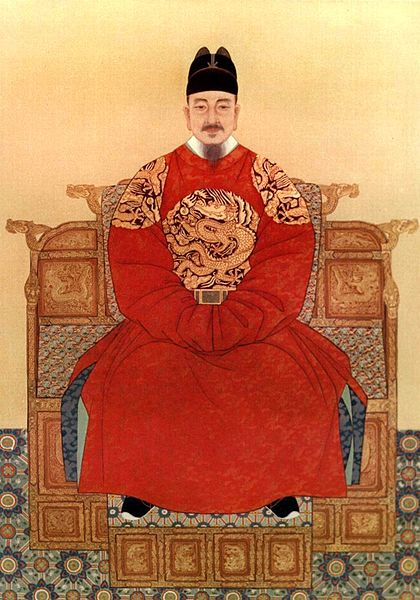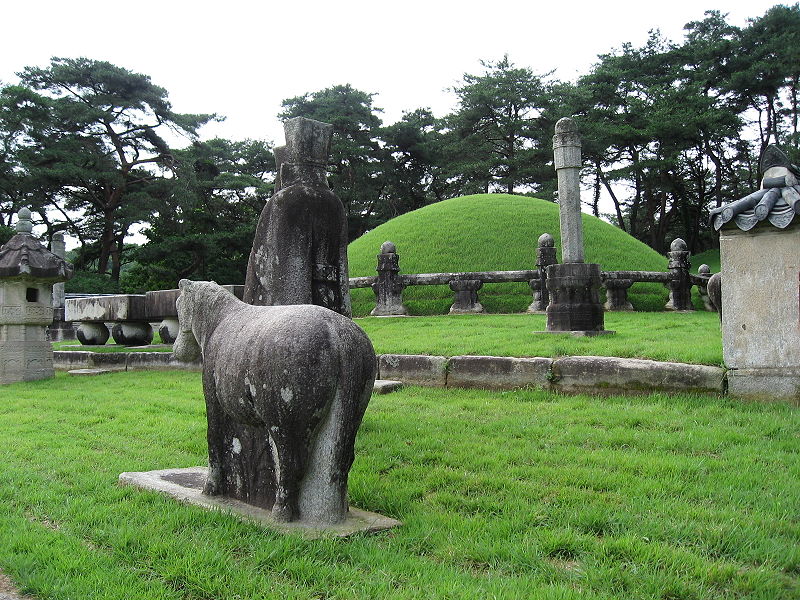<Back to Index>
- Philosopher David Hume, 1711
- Writer and Revolutionary Olympe de Gouges, 1748
- King of Joseon Sejong Daewang, 1397
PAGE SPONSOR


Sejong the Great (May 7, 1397 – May 18, 1450, r. 1418–1450) was the fourth king of the Joseon Dynasty of Korea. During his regency, he reinforced Korean Confucian policies and executed major legal amendments (공법; 貢法). He also used the creation of Hangul and the advancement of technology to expand his territory. He is the third son of King Taejong and Queen Consort Wonkyeong. Sejong is one of only two Korean rulers posthumously honored with the appellation "the Great", the other being Gwanggaeto the Great of Goguryeo.
Sejong was born on May 7, 1397, the third son of King Taejong. When he was twelve, he became Grand Prince Choong - Nyung' (충녕대군; 忠寧大君) and married a daughter of Shim On (심온; 沈溫) of Cheongsong (청송; 靑松), commonly known as Lady Shim (심씨; 沈氏), who later was given the title Queen Soheon (소헌왕후; 昭憲王后). As a young prince, Sejong excelled in various studies and was favored by King Taejong over his two older brothers.
Sejong's ascension to the throne was different from those of most other kings. Taejong's eldest son, Yangnyeong (양녕대군), viewing himself as lacking in the requisite skills for kingship, believed that his younger brother Sejong was destined to become king. He believed it was his duty to place Sejong as king, so he acted rudely in the court and was soon banished from Seoul. This plot ultimately brought Sejong to the throne. The eldest prince became a wandering traveler and lived in the mountains. The second son traveled to a Buddhist temple, where he became a monk.
In
August of 1418, following Taejong's abdication two months earlier,
Sejong ascended the throne. However, Taejong still retained certain
powers at court, particularly regarding military matters, until he died
in 1422. King Sejong was an effective military planner. He created
various military regulations to strengthen the safety of his kingdom, supported the advancement of Korean military technology, including cannon development. Different kinds of mortars and fire arrows were tested as well as the use of gunpowder. In May 1419, King Sejong, under the advice and guidance of his father Taejong, embarked upon the Gihae Eastern Expedition, the ultimate goal of this military expedition being to remove the nuisance of Japanese pirates who had been operating out of Tsushima Island. During the expedition, 243 Japanese were killed, and another 110 were
captured in combat, while 180 Korean soldiers were killed. 146 Chinese
and 8 Korean kidnapped were liberated by this expedition. In September
of 1419 the Daimyos of Tsushima and Sadamori capitulated to the Joseon court. The Treaty of Gyehae was signed in 1443,
in which the Daimyo of Tsushima recognized and obeyed the suzerainty of
the King of Joseon; in return, the Joseon court rewarded the Sō clan
preferential rights regarding trade between Japan and Korea. In 1433, Sejong sent Kim Jong-seo (hangul: 김종서, hanja:
金宗瑞), a prominent general, north to destroy the Manchu. Kim's military
campaign captured several castles, pushed north, and restored Korean
territory, roughly the present day border between North Korea and China. Four forts and six posts were established (hangul: 사군육진 hanja: 四郡六鎭) to safeguard the people from Jurchen nomads. Sejong
is credited with technological advances during his reign. He wanted to
help farmers so he decided to create a farmer's handbook. The book — the
Nongsa jikseol (hangul: 농사직설, hanja:
農事直說) — contained information about the different farming techniques that
he told scientists to gather in different regions of Korea. These
techniques were needed in order to maintain the newly adopted methods
of intensive, continuous cultivation in Korean agriculture. During his rule, Jang Yeong-sil (hangul: 장영실, hanja:
蔣英實) became known as a prominent inventor. Jang was naturally a
creative and smart thinker as a young person. However, Jang was at the
bottom of the social class. Taejong, the father of Sejong, noticed
Jang's skill and immediately called him to his court in Seoul. Upon
giving Jang a government position and funding for his inventions,
officials protested, believing a person from the lower classes should
not rise to power among nobles. Sejong instead believed Jang merited
support because of his ability. Jang created new significant designs for water clocks, armillary spheres, and sundials. However, his most impressive invention came in 1442, the world's first rain gauge;
this model has not survived, since the oldest existent East Asian rain
gauge is one made in 1770, during the reign period of King Yeongjo. According to the Daily Records of the Royal Secretariat (hangul: 승정원일기, hanja:
承政院日記) King Yeongjo wanted to revive the glorious times of King Sejong
the Great, and so read chronicles of Sejong's era. When he came across
mention of a rain gauge, King Yeongjo ordered a reproduction. Since
there is a mark of the Qing Dynasty ruler Qianlong (r. 1735 – 1796) of China, dated 1770, this Korean designed rain gauge is sometimes misunderstood as having been imported from China. Sejong also wanted to reform the Korean calendar system, which was at the time based upon the longitude of the Chinese capital. Sejong, for the first time in Korean history, had his astronomers create a calendar with the Korean capital of Seoul as the primary meridian. This new system allowed Korean astronomers to accurately predict the timing of solar and lunar eclipses. In the realm of traditional Korean medicine, two important treatises were written during the reign of Sejong. These were the Hyangyak jipseongbang and the Euibang yuchwi,
which historian Kim Yongsik says represents 'Koreans' efforts to
develop their own system of medical knowledge, distinct from that of
China.' They were now separated. Sejong
supported literature, and encouraged high class officials and scholars
to study at the court. King Sejong created the written language of
hangul and announced it to the Korean people in the Hunminjeongeum (Hangul:훈민정음, Hanja: 訓民正音), meaning 'The verbally right sounds meant to teach the people.' Sejong
depended on the agricultural produce of Joseon's farmers, so he allowed
them to pay more or less tax according to fluctuations of economic
prosperity or hard times. Because of this, farmers could worry less
about tax quotas and work instead at surviving and selling their crops.
Once the palace had a significant surplus of food, King Sejong then
distributed food to poor peasants or farmers who needed it. In 1429 Nongsa - jikseol (hangul: 농사직설, hanja:
農事直說) was compiled under the supervision of King Sejong. It was the
first book about Korean farming, dealing with agricultural subjects
such as planting, harvesting, and soil treatment. Although
most government officials and aristocrats opposed usage of hangul,
lower classes embraced it, became literate, and were able to
communicate with one another in writing. Sejong's personal writings are also highly regarded. He composed the famous Yongbi Eocheon Ga ("Songs of Flying Dragons", 1445), Seokbo Sangjeol ("Episodes from the Life of Buddha", July 1447), Worin Cheon - gang Jigok ("Songs of the Moon Shining on a Thousand Rivers", July 1447), and the reference Dongguk Jeong - un ("Dictionary of Proper Sino - Korean Pronunciation", September 1447). In 1420 Sejong established the Hall of Worthies (집현전; 集賢殿; Jiphyeonjeon) at the Gyeongbokgung Palace.
It consisted of scholars selected by the king. The Hall participated in
various scholarly endeavors, of which the best known may be the
compilation of the Hunmin Jeongeum.
King Sejong the Great profoundly impacted Korean history with his introduction of
hangul, the native phonetic alphabet system for the Korean language. Before
the creation of Hangul, only members of the highest class were literate
(hanja was typically used to write Korean by using adapted Chinese
characters, while Hanmun was
sometimes used to write court documents in classical Chinese). One
would have to learn the quite complex hanja characters in order to read
and write Korean. Further, despite modifications to the Chinese
characters, hanja could prove cumbersome when transcribing the Korean
language, due to considerable differences in grammar and sentence order.
King
Sejong presided over the introduction of the 28 letter Korean alphabet,
with the explicit goal being that Koreans from all classes would read
and write. He also attempted to establish a cultural identity for his
people through its unique script. First published in 1446, anyone could
learn Hangul in a matter of days. Persons previously unfamiliar with
Hangul can typically pronounce Korean script accurately after only a
few hours study. Each
hangul letter is based on a simplified diagram of the patterns made by
the mouth, tongue and teeth when making the sound related to the
character. Morphemes are built by writing the characters in syllabic blocks. The blocks of letters are then strung together linearly. Sejong was blinded by later years by diabetes complications and died at the age of 54 and was buried at the Yeong Mausoleum (영릉; 英陵) in 1450. His successor was his first son, Munjong. Sejong judged that his sickly son Munjong was unlikely to live long and on his deathbed asked the Hall of Worthies scholars to look after his young grandson Danjong. As predicted, Munjong died two years after his accession, and political stability enjoyed under Sejong disintegrated when Danjong became the sixth king of Joseon at the age of twelve. Eventually, Sejong's second son Sejo usurped the throne from Danjong in 1455. When six martyred ministers were
implicated in a plot to restore Danjong to throne, Sejo abolished the
Hall of Worthies and executed Danjong and many ministers who served
during Sejong's reign. The street Sejongno and the Sejong Center for the Performing Arts – both located in central Seoul – are named after King Sejong, and he is depicted on the South Korean 10,000 Won note. In
early 2007, the Republic of Korea government has decided to create a
special administrative district out of part of the present Chungcheongnam-do Province, near what is presently Daejeon. The new district will be named Sejong Special Autonomous City, and is to replace Seoul as the future capital of the Republic of Korea. The life of Sejong was depicted in the KBS Korean historical drama King Sejong the Great (TV series) in 2008.